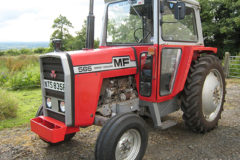Ford 600 Series
Posted by Chris Graham on 12th January 2020
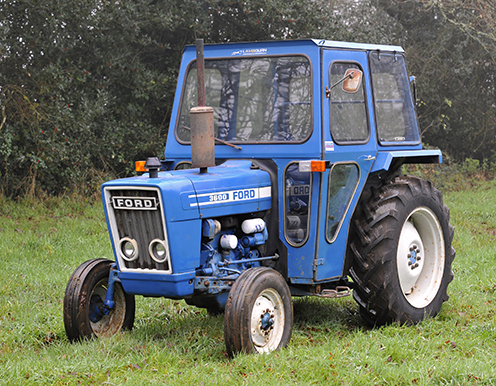
If you’re after a no-nonsense classic tractor that’s affordable to buy, restore and maintain then, as this buying guide explains, something from the Ford 600 Series could be just the thing
The 600 Series of three- and four-cylinder tractors from Ford first hit the UK market in 1975, and included an impressive nine model variants. Although the smaller offerings in the new range (classified 7A1 within Ford) appeared pretty similar to the outgoing Force range, the new machines actually benefitted from a number of engine efficiency- and hydraulic system-based improvements.
Ford was evidently keen to build on the impressive success of its Force models and, at the bottom of the model line-up, the 2600, 3600 and 4600 were fitted with the same Fieco cab. Engine power output was kept the same for these models, too, but the new 7600 got a 3hp boost – to 97hp – thanks to the addition of a new turbocharger and some additional mechanical mods.
Two new models replaced the old Force 5000, the 5600 and the 6600, and it was the latter – with its 78hp, naturally-aspirated four-cylinder engine – which was destined to become one of the most popular sellers. The 8600 and 9600 versions sat at the top of the 600 range, with powerful outputs and Hara cabs. Finally, there was the slight oddity of the range, the 4100. The model replaced the previous 3055, and was powered by a 52hp, three-cylinder engine.
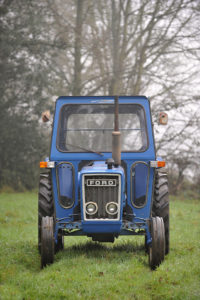
The smaller 600 Series models, like this three-cylinder, 48hp 3600, tended not to be as popular as the more powerful mid-rangers
Rapid upgrade
However, the initial 600 Series range was only current for about six months as, in late spring of 1976, Ford introduced the 7A2 versions that featured the company’s new Q cab (quiet cab). This refinement was forced on the whole tractor industry by government legislation stipulating that noise levels for tractor drivers had to be limited to a maximum of 90 decibels. Ford produced a real winner with its new cab design which, thanks to the use of curved windscreen glass, quickly became known as the ‘bubble’ cab. It did its job well and looked great, lifting the image of the 600 Series to a new level.
While the 8600 and 9600 models retained their Hara cabs, not all buyers of the smaller models opted for the Q cab, with many – particularly livestock farmers with height-restricted barn or shed entrances to negotiate – preferring the lower-profile but less stylish version from Lambourn. A few years later, in 1980, Ford introduced the Italian-made Carraro front axle, to give the 600 Series a more versatile, four-wheel-drive option. At the same time, all four-cylinder models were given engine tweaks to increase power outputs, creating the ‘Power Plus’ versions (complete with a ‘piston plus’ logo on the radiator cowling). As a result of these engineering improvements, the 5600’s peak output was increased to 75hp, the 6600 delivered 86 and the 7600 notably cracked the 100 barrier, with an output of 103hp.
The final, notable event in the story of the 600 Series was the arrival of the 7600E model, which was launched in 1980. Intended as an entry-level model, this ‘economy’ version featured a basic specification (no load monitor), small wheels but the standard, 103hp engine. By making these economies, Ford was able to shave £1,000 or so off the list price, and identified the model with a large, blue ‘E’ on the tractor’s nose. Production of the 600 Series officially ended in 1982.
Smart choice?
To learn more about what the 600 Series is like in practice, to discover the secrets of buying a good one and what these nearly 40-year-old machines are like to own today, I took a trip to Worcestershire to visit Ford tractor enthusiast, Tim Pearman. Tim has owned several 600s in the past, and currently has a couple of them in his extensive tractor collection. As such, he’s perfectly placed to offer some experienced-based hints and tips for would-be owners.

As standard, the four-cylinder engine in this smart 1983 6610 produced 78hp, although it’s believed this one is fitted with a 96hp unit from a 7600
The first point that he made was that models from the 600 Series range are actually extremely good tractors that, even today, are perfectly viable as working machines. They’re both modern enough and sufficiently powerful to be genuinely useful for any number of jobs around the farm or smallholding and, of course, are a great option if you fancy getting involved with competitive ploughing.
“As you know, the 600 Series machines built on the considerable success that Ford had enjoyed with the Force models,” Tim told me. “In fact, the smaller models in the new range looked very similar to those they were replacing, although all of them were fitted with a cab and also benefitted from a bit more power. Overall, though, the engines remained simple and straightforward, and these tractors were the last generation to be free from ‘modern’ electronics. This gives them a real, practical advantage in my view, especially for first-time owners.
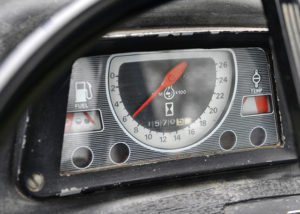
Simple instruments characterise the pre-electronics era in which the 600 Series tractors were built
“There’s a beautiful simplicity to the 600 Series tractors, which Ford started to lose the moment electronic management started to gain a hold. It began with digital instrument clusters then crept into electronic engine and transmission management, and with those advances came a whole host of extra complication.
“Also, given that these machines date mainly from the mid-to-late 1970s, the 600 models hadn’t really been dragged into the ‘race for power’, so their three and four-cylinder engines, transmissions and rear axles are unstressed and extremely reliable as a result. What’s more, they come from a time when a good degree of over-engineering still existed in the production process, which is another reason why they remain so reliable and usable today, 40 years after they left the factory.”
Creature comforts
Tim continued: “Of course, another big advantage of these 600 Series machines is that they all had a decent cab. Ford did a great job in this respect, improving the driving environment no end. I can remember some of the awful cabs that other manufacturers introduced at the time, in a bid to meet with the new noise regulations. A badly designed and mounted cab could actually be worse for the driver than not having one fitted at all. The unpleasant resonances and irritating vibrations generated inside a poor quality cab, could make using a tractor a miserable experience. Thankfully, this wasn’t the case with Ford.”
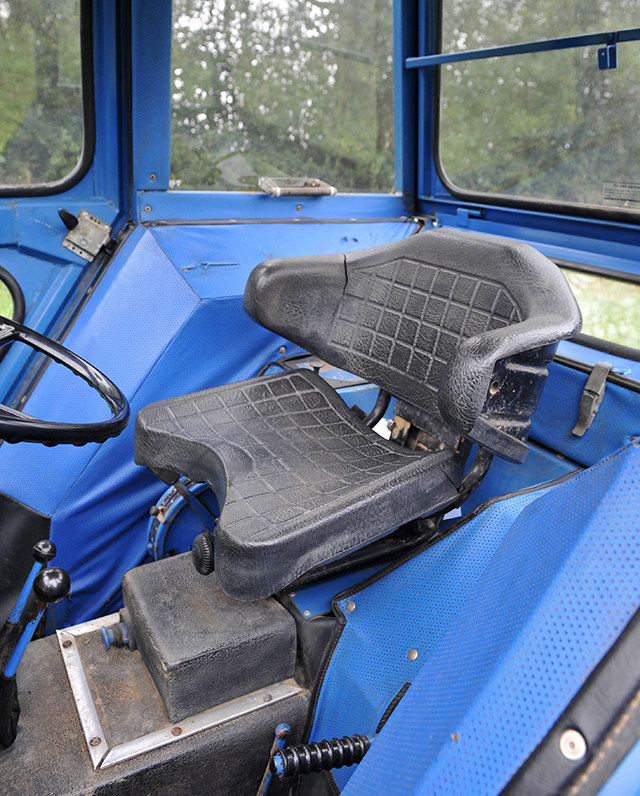
It was from this era onwards that tractor manufacturers started considering the needs and comfort of the driver
With regard to buying, Tim’s view is that bagging yourself a decent 600 Series tractor is more about common sense than anything else. “The fact that these machines were well built and reliable means that you’re unlikely to come across any real no hopers. Parts availability is still good, so everything is repairable; it just depends how much money you have to spare, and what you buy the tractor for in the first place.
“Looking at a prospective purchase must involve all the usual checks to assess general wear and tear levels. All the usual basics apply, and you should never be afraid to walk away from a machine that turns out not to be as it was described in the advert. Pay attention to the recorded hours, and make a judgement about whether these ‘match’ the overall condition of the machine. Do the wear levels on the seat, steering wheel and pedals reflect the hours total showing? It’s always possible that the cable has ‘become disconnected’ from the clock at some point in the past…
“Delve into the tractor’s working history, if possible. A machine that’s only ever been used for bailing and haymaking is always going to be a better bet than one that’s lived its life on the slurry tanker. Also, machines that have been used for hedge-cutting, or pulling a feeder wagon, may be in noticeably worse condition on one side, than the other. So, beware if the prospective purchase you’re looking at is parked against a wall!
“A lot of 600 Series tractors were used by dairy farmers, simply because of their versatility; they could drive a forage harvester, tow a trailer, pull a scraper etc. The combination of relatively small size and decent power output, made them very popular all rounders, which means that many have seen hard, working lives. While a larger machine would typically be reserved just for ploughing, spending most of its life in the shed accordingly, the multi-purpose functionality of smaller machines like the 6600 or 7600, meant they tended to be worked year-round.”
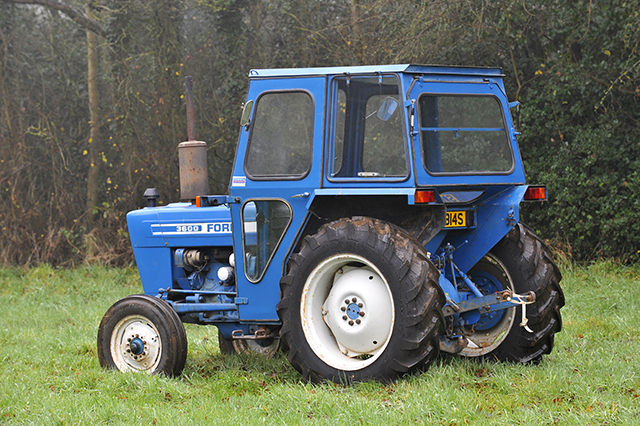
It’s important to be aware of the cab corrosion risk on 600 Series tractors. It can be expensive to repair
Engine issue
However, like most other models, the Ford 600 Series tractors weren’t without their faults, and the main problem that gripped these machines concerned premature engine failure. “Porous block issues were at the heart of it in this case,” Tim explained. “Under the right conditions, coolant would leak into the oil, leading to overheating and – if ignored – engine seizure. This fault affected a great many of the early 600s and Ford’s solution was simple and effective; it replaced all damaged engines under warranty.
“The replacement engines featured a re-designed block, identified by obvious, ‘criss-cross’ marking on the outside of the casting. It’s difficult to put specific dates on when this problem struck because it didn’t occur in all cases. Those tractors that were worked the hardest were the ones that suffered first, with the engineering weakness being exposed by the heavy, mechanical loading. In other cases, though, the problem didn’t occur for ages, if at all. Ford was lucky, though, that what was a disastrous public relations story didn’t do more damage to the 600 Series, and the company itself.
“In those days, of course, customers were very loyal to the brand; farmers who’d always bought and used Ford, tended to stick with the brand, through thick and thin. Also, the fact that the company was so quick to react to the problem, and offered a no quibble engine replacement when problems arose, undoubtedly did much to reassure the market, and rebuild whatever damage had been done to the Ford name.”
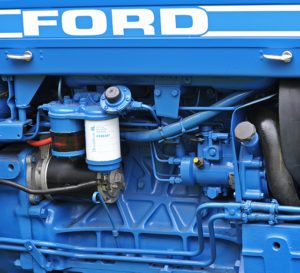
The ‘criss-cross’ casting pattern of this re-designed Ford engine is clear to see. These units were fitted to deal with the porous block problem
It’s fair to say that most examples you’ll find for sale now will be fitted with a revised, ‘criss-cross’ engine, so the porous block problem is an issue that should be consigned to the history books. Nevertheless, it still makes sense to check the condition and level of the oil in any prospective purchase. Tim continued: “Take the cap off the radiator to check for any signs that the oil and coolant might be mixing – a pale brown, mayonnaiselike sludge is the warning sign to watch for. Listen carefully to the engine running (assuming it does!), taking note of its smoothness and the presence of any suspicious knocking.
“Make sure that every gear can be engaged, and that each operates without undue mechanical whining, then assess the brakes and steering – excessive play and clonking from the kingpins and joints are obvious signs of wear. The brakes are inboard, so dealing with problems is more involved than on earlier machines. But, problems like this are all fixable, and shouldn’t cost a fortune (especially if you have some DIY skills yourself). Nevertheless, finding such issues will always provide good ammunition to help with negotiating a lower sale price!
“The other factor to be aware of is cab corrosion, the severity of which will vary enormously, depending on the tractor’s working history. Check all the lower parts of the cab, especially along the bottom edges of the windows. Buyers should be aware that dealing with cab corrosion properly can be expensive. If the structure has to be removed from the tractor, stripped, repaired and re-painted, then the bill for that can easily amount to £2,000+, especially if the work is entrusted to a specialist restorer.” So, given what you’ve just read, I hope you can now appreciate that it’s almost impossible to make a serious mistake when buying a 600 Series tractor. The engineering simplicity of these machines, coupled with the decent and affordable parts availability situation, mean that just about any example will be recoverable without having to spend a fortune. Of course, much will depend on the standard of finish you’re after but, if you’re happy to settle for a smart, usable example, then restoration should be financially viable in most cases.
What’s more, with 600 Series values beginning to crawl upwards, now could be a good time to buy. It’s always gratifying to catch a bargain at the bottom of an appreciating market, and that’s exactly what seems possible now with this range of tractors. But, more than that, those who opt to take the plunge will not only be buying themselves a tractor that’s on the up in the desirability stakes, but will also be getting a goodlooking, still capable, easy-to-own and fun-to-work machine; a genuinely simple pleasure.
WHAT TO PAY?
It’s very unlikely that you’ll come across a mint 600 Series nowadays so, in reality, anything you do buy is going to require some renovation work to bring it back to good condition. With this in mind, you’ll probably need £2,000 – £3,000 reserved in a ‘fighting fund’ to meet the cost of the work that’ll almost inevitably be needed.
To buy a running example which is complete – but in need of work – you should expect to pay about £4,000-£5,000 but, at this price, it’ll be a tractor that’s worth spending £3,000-£4,000 on to bring it back up to scratch.
There seems little doubt that Ford 600 Series tractors are appreciating now, and you should be prepared to spend about £10,000 for one of the very best available in today’s market. However, examples genuinely deserving of this price tag will be few and far between.
Owner’s view: Tim Pearman
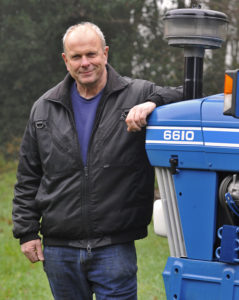 “I started collecting Ford 10 Series tractors when people began trading them in to upgrade to the 40 Series which, in my view, wasn’t as well built or reliable as the 10. I think the 10 Series is one of the best tractors that Ford has ever made, and its values have increased significantly in recent years, making good examples increasingly difficult to find. As a consequence, the desirability spotlight is now turning towards the next best thing, which many regard as the Ford 600 Series.
“I started collecting Ford 10 Series tractors when people began trading them in to upgrade to the 40 Series which, in my view, wasn’t as well built or reliable as the 10. I think the 10 Series is one of the best tractors that Ford has ever made, and its values have increased significantly in recent years, making good examples increasingly difficult to find. As a consequence, the desirability spotlight is now turning towards the next best thing, which many regard as the Ford 600 Series.
“Back in the day, I spent a good many hours using a 6600 for muck-spreading duties, and quickly grew to really like it. Everything about it was straightforward, which made it a really good working tractor. You simply turned the key and off you went. Reliability levels were superb, the maintenance and servicing requirements were no problem and, overall, it was great to live with.
“I also found the cab to be better lasting than the ones fitted to the later 10 Series models. Perhaps the 600 Series machines got a better paint job, or the cabs were made using slightly thicker metal. The 6610 I now own, with its bubble cab, came from a sale in Leamington Spa, and only has 3,500 hours on the clock. It was fitted with a loader which I’ve since removed and sold, and also has an engine from a 7600. I’m assuming the swap was done by Ford to deal with a porous block issue.
“While the spare parts situation is pretty good, the quality can be a bit variable on some of the pattern parts manufactured abroad. I’ve run into a few fitting problems, most recently with some trim panels I bought for the inside of my 6610’s cab. I found that these were a real struggle to fit and make look good, particularly over the wheel arches.
“I’m always careful with the tractors that I restore, not to turn them into museum pieces. I want to be able to use my machines, and feel comfortable doing so. For me, I don’t want them finished to such a high standard, that I’m afraid of using the pedals for fear of taking the paint off with my boots.
“I can’t really see any point in making a tractor better than it was when it left the factory, and I think that some owners get a little carried away, in this respect. Don’t get me wrong, they produce superb machines which are beautifully presented but, as far as I’m concerned, it’s important that a tractor remains able to work properly in a field.”
To subscribe to Ford & Fordson Tractors, click here



